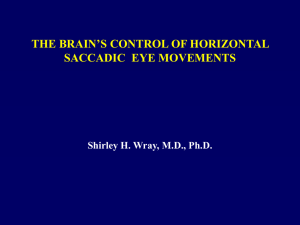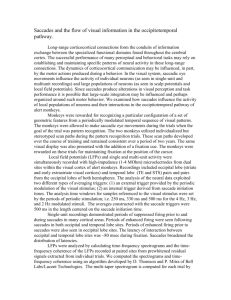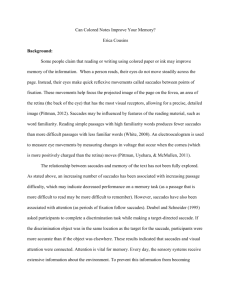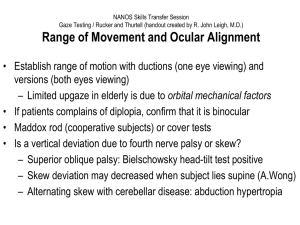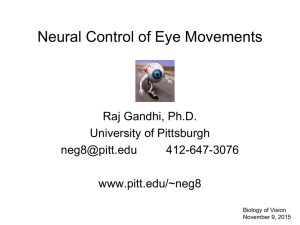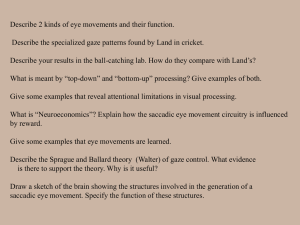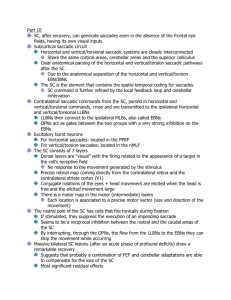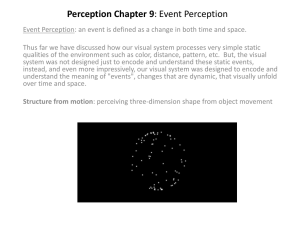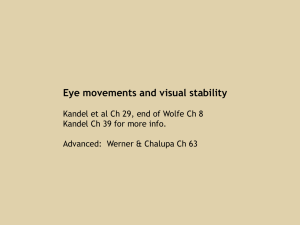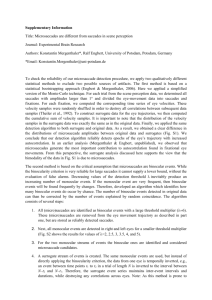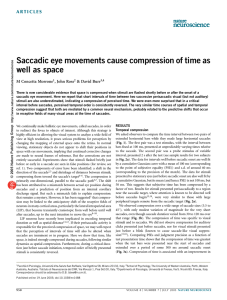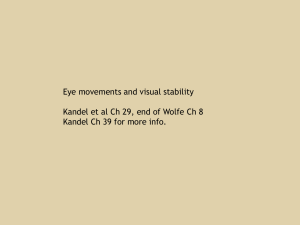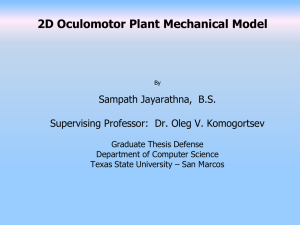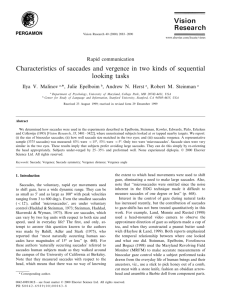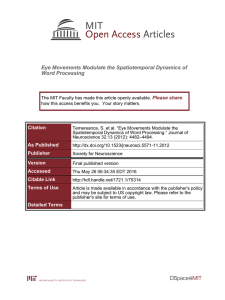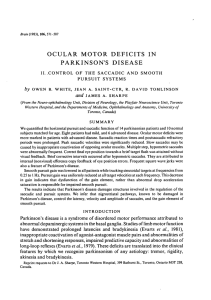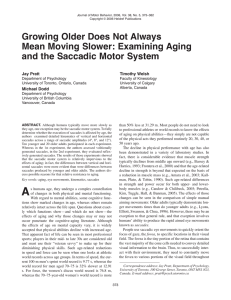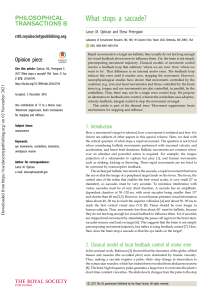Saccades_guest_lecture - NOVEL
advertisement
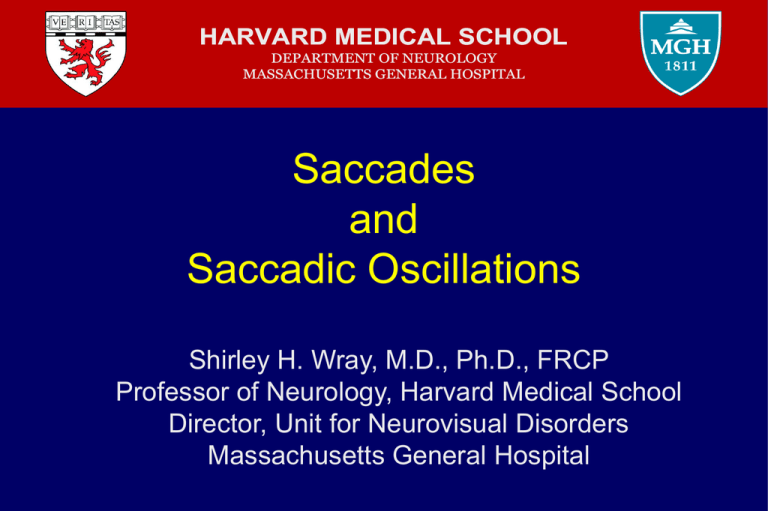
HARVARD MEDICAL SCHOOL DEPARTMENT OF NEUROLOGY MASSACHUSETTS GENERAL HOSPITAL Saccades and Saccadic Oscillations Shirley H. Wray, M.D., Ph.D., FRCP Professor of Neurology, Harvard Medical School Director, Unit for Neurovisual Disorders Massachusetts General Hospital Saccades are fast eye movements that bring the image of an object onto the fovea Pulse-Step Innervation During a saccade, motoneurons and the agonist muscles “ fire” moving the eye quickly from one position to another – the PULSE After a saccade, motoneurons and the agonist muscle assume a “tonic” activity, holding the eye in a new position – the STEP Saccades The step (an eye position command ) is derived from the pulse ( an eye velocity command). This is performed by the velocity-to-position neural integrator, which integrates a velocity command to yield a position command ( gaze holding mechanism ) The Neural Integrators For horizontal movements in the medulla the medial vestibular nucleus (VN) and the nucleus prepositus hypoglossi (NPH) For vertical and torsional movements in the midbrain the interstitial nucleus of Cajal (INC) Courtesy of Agnes M.F. Wong. MD, PhD, FRCSC Courtesy of Agnes M.F. Wong. MD, PhD, FRCSC Normal Saccades Velocity range 30-700 degrees /sec Duration 30-100 msec Accuracy small amplitude tend to overshoot large amplitude undershoot Latency ( initiation time ) 150-250 msec Pulse-Step Abnormal Velocity TOO SLOW The Slow Saccade Syndrome Slow Saccade Syndrome Video ID 933-1 Paraneoplastic Syndrome A novel paraneoplastic brainstem syndrome characterized by selective slowing of horizontal saccades in association with facial spasms and occult prostate carcinoma. Baloh RW et al. Neurology 1993;43:2591-2596. Brainstem encephalitis, especially with anti-Ma2 antineuronal antibodies and testicular carcinoma, may also produce saccadic slowing but vertical gaze is also affected. Dalmau J. Brain 2004;127:1831-1844. Selective Saccadic Palsy following Cardiac Surgery Selective loss of all forms of saccades (voluntary and reflexive quick phases of nystagmus) with sparing of other eye movements. Video 207-2 Patterns of Saccadic Movements Slow saccades that carry the eye almost to the target. A “staircase” of 10 or more small saccades, to acquire the target. *Seen clinically like a slow smooth movement Hypometric saccades combined with slowing. Loss of all ability to make saccades and reflexive quick phases. Patterns of Saccadic Movements Slow horizontal and vertical saccades 9/10 Slow vertical saccades only 1/10 Slow horizontal saccades only – 0/10 Solomon D et al., Ann Neurol 2007; 62: 1-11 Solomon D et al., Ann Neurol 2007; 62: 1-11 Slow Saccade Syndrome Progressive Supranuclear Palsy A saggital T2-WI MR in a patient with advanced progressive supranuclear palsy showing the tectal plate is markedly thinned and atrophic. Courtesy Anne Osborn, MD Video 939-3 Video 932-3 Video 921-1 Slow Saccade Syndrome Courtesy of Agnes M.F. Wong. MD, PhD, FRCSC Increased Latency Cognitive Control of Saccades Ocular Motor Apraxia Frontotemporal Dementia Courtesy of Anne Osborn MD Video ID 925-3 Video 162-6 Increased Latency Cognitive Control of Saccades Balint’s Syndrome Michael Balint 1896-1970 Balint’s Syndrome Psychic paralysis of gaze - impaired initiation of voluntary saccades to visual stimuli ( optic apraxia ) - peripheral visual inattention impeding visual search ( simultanagnosia ) - inability to accurately direct hand or other movements to visual stimuli ( optic ataxia ) Sagittal T1WI MR in a patient with advanced Alzheimer’s disease showing striking enlargement of the sylvian fissure and frontal sulci Courtesy Anne Osborn, MD Video 945-5 Inaccuracy Cerebellar Control of Saccades The cerebellum regulates the size of saccades A lesion of the dorsal vermis results in dysmetria and slow saccades A lesion of the fastigial nucleus causes prominent saccadic hypermetria. Pursuit is normal ID 917-5 Video 166-12 Opsoclonus in the dark Opsoclonus Characterized by spontaneous involuntary rapid multidirectional back-to-back saccades without a saccadic interval that persist in sleep Video 931-1 Ocular Flutter Ocular flutter refers to spontaneous bursts of very rapid horizontal back-to-back saccadic oscillations around the point of fixation Ocular flutter and opsoclonus may occur together, simultaneously or in sequence or the patient may have only one or the other. Video 936-7 Video 936-8 Courtesy of Agnes M.F. Wong. MD, PhD, FRCSC Functial MRI during opsoclonus: activation found in the cerebellum but not in the pontine brainstem aligns with medial deep cerebellar nuclei and probably involves the fastigial nucleus Helmchen C, Rambold H, Erdmann C et al. Neurology 2003; 61: 412-534 Acknowledgement Nancy Lombardo, Systems Librarian Spencer S. Eccles Health Sciences Library, University of Utah, Salt Lake. Leigh JR, Zee DS. The Neurology of Eye Movements 4th Edition. Oxford University Press, New York, 2006. Wong A.M.F. Eye Movement Disorders. Oxford University Press, New York, 2008. http://library.med.utah.edu/NOVEL/Wray/ http://library.med.utah.edu/NOVEL/Wray/ Web address pending Web address pending

